Following a recent trip to Wales, RailAdvent contributor, Jon Aston, writes about his journeys on some of the Welsh narrow gauge railways.
After a long winter, we fancied a short break. Having looked at a few overseas destinations, we decided to stay in the UK; as we both love Wales, we settled upon Aberdovey in West Wales.
The accommodation was booked for four nights at the end of April. The plan was to do lots of walking, enjoy meals out and give our dog Mollie plenty of visits to one of her favourite places, the beach.
We did all that, but following my visit to the Statfold Barn model railway show on April 1st, the trip became a railway-based holiday.
While at Statfold, I was looking around the stalls, and while at the Talyllyn Railway display, I chatted with Frank Nolan, a Trustee of the railway. Frank talked to me about membership of the railway; for the sum of £30, I could join the Talyllyn Railway Preservation Society, and my wife could join as an associate member for £15.
The adult day fare, which gives unlimited travel on the line for one day, is £ 22.70, with membership costing us only 40p than day tickets buying membership seemed great value especially as membership affords you unlimited travel on the railway for the 12 months of its validity, plus half price travel on the Ffestiniog and Welsh Highlands Railways.
I had to check this with Frank several times as the offer seemed too good to be true. So I left Statfold with a full and associate membership paid for and a plan for our trip hatched.
We would visit and ride on both Talyllyn and Ffestiniog railways during our stay; luckily, my wife seemed fine with the programme as long as the planned walks and meals out also happened.
Due to health reasons, I am not allowed to drive. Instead, I rely on my wife and public transport to get around. My wife Sarah is a community nurse and does a lot of driving for work. Therefore, we wanted to enjoy a trip with minimal driving to give her a break from the wheel.
Sarah drove us from our Shropshire home to our accommodation on the afternoon of Monday, 24th April. After we arrived, she parked our van, where it would stay until our journey home the following Friday. Our means of transport for our stay would be either on foot or by train.

On our first full day, we enjoyed a walk in the hills behind Aberdovey and then caught the first train of our trip from Penhelig Station to Fairborne.
Aberdovey has two railway stations – Aberdovey Station and Pennelig Station. Penhelig was built by the Great Western Railway and opened in 1933.
It is now a request stop and was the closest station to our accommodation, less than 10 minutes walk away. We stood on the platform and waved at the driver as the train pulled into the station. We boarded the class 158 diesel unit 158825 for the 33-minute journey to Fairbourne.
Except for the odd class 97 loco-hauled excursion, all passenger trains on the Cambrian Line are operated by class 158 units. The Cambrian Line runs from Shrewsbury in the English border county of Shropshire to Dovey Junction, where trains can travel north via the Cambrian Coast Line to Pwhelli or south to Aberystwyth.
The Cambrian Coast Line spans 120 miles of railway and is undoubtedly one of the most scenic routes in the United Kingdom.
In 2011 the Cambrian Coast Line was converted to the ETCS (European Train Control System). ETCS is an advanced train control system in which all information is relayed directly in cab to the train driver. This removes the need for lineside signaling equipment. Instead, train movements are controlled from a highly technical signaling and control centre in Machynlleth. Some Transport for Wales class 158 units and a few Network Rail class 97 locomotives are equipped to operate on the line. New generation class 197 diesel units are currently being fitted with the required equipment and will replace the 158 units over the coming couple of years.
We alighted our train at Fairbourne and took a ride on the Fairbourne Railway, a 12.25-inch miniature railway that runs for 2 miles from the small town of Fairbourne to Barmouth Ferry Station.
The line started life as a 2 ft gauge tramway in 1895 and was originally built to serve the construction of Fairbourne Village using horse-drawn tram cars, the tramway soon introduced passenger cars to transport people to the Ferry Station.
In 1916 the line was converted to I5-inch gauge, and steam power was introduced; the railway was converted to appeal to tourists. The line operated in 15-inch gauge until 1940 when. It closed to reopen again in 1947.
In 1986 the railway was converted to a 12-inch gauge, and a new station was constructed at Fairbourne, which became the railway that exists today. The railway is owned and operated by the North Wales Coast Light Railway Limited.
Our locomotive for the trip was a 0-4-0 saddle tank, ‘Sherpa,’ built in 1978 by Milner Engineering for a railway in France. The loco originally named ‘France’ was renamed upon its arrival at Fairbourne. ‘Sherpa’ is a half-size replica of a Darjeeling Class B locomotive.

We travelled in an enclosed coach to Barmouth Ferry Station and then returned to and alighted at Estuary Halt. During the Summer months, passengers can catch a ferry from Barmouth Ferry Station and cross the estuary to Barmouth.
From Estuary Halt, we walked to Barmouth crossing the Iconic 820 metre long Barmouth Viaduct. From Barmouth, we caught 158828 back to Aberdovey.
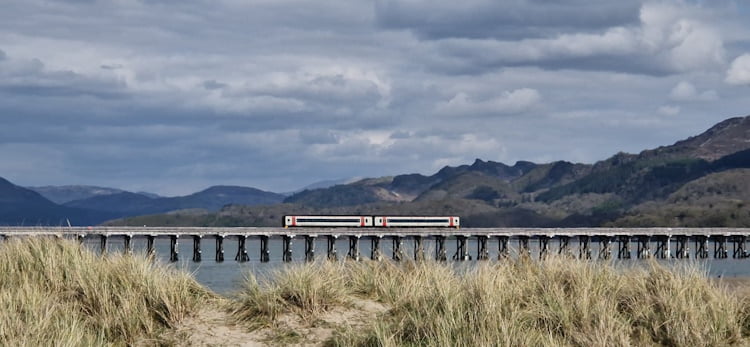
Our second full day saw us once again catch a train from Penhelig; this time, our train was formed of 158820, which we took for the short journey to Tywyn and the Talyllyn Railway.
We presented our membership cards at the ticket office and were given our complimentary members’ tickets to travel. I had to pay just £4 so that our dog Mollie could travel with us.
I had a look around the fascinating Narrow Gauge Railway Museum at Tywyn Station before our train; this is a must-visit place for anyone interested in the history of narrow-gauge railways.
We caught the 10:30 departure from Tywyn on a gloriously sunny morning. Our locomotive for the first part of the journey was 0-4-2 saddle tank engine No 3 ‘Sir Haydn.’
The loco was built by Hughes’s Locomotive & Tramway Engine Works (later known as the Falcon Works), Loughborough, in 1878, for the Corris Railway near Machynlleth, where the loco worked until the closure of the line in 1948. Since 1951 the loco has worked at the Talyllyn Railway.
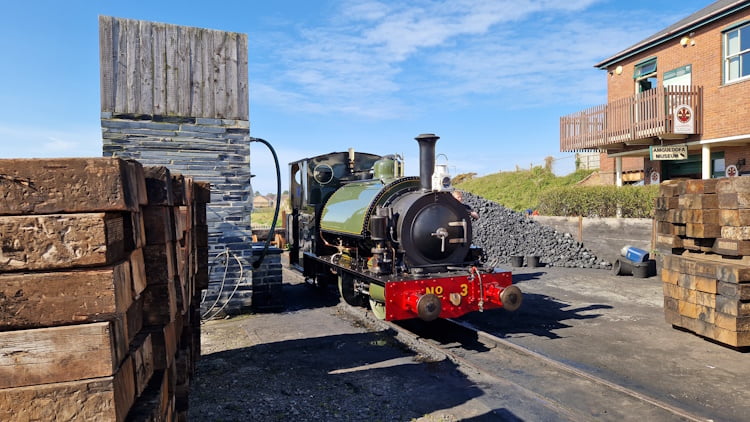
We rode behind Sir Haydn for the entire seven ¼ mile length of the line to Nant Gwernol. The railway was originally opened in 1865 to carry slate from the quarry at Bryn Eglwys to Tywyn. It became the first narrow gauge steam railway granted permission by an act of parliament to carry passengers. Despite underinvestment, the line stayed open until 1951, when it became the first railway in the world to be preserved as a heritage railway maintained and operated by volunteers.
We left the train at Nant Gwernol and did a 5-mile walk taking in the spectacular Quarry Inclines Heritage Trail and then on to Abergynolwyn Station. On this walk, we passed the remains of six inclines that were used to haul up or lower trucks of slate from one level section of the railway to another. I find the fact that nature has taken over a once highly industrialised landscape quite captivating and full of hope that whatever we do to our environment that in due course of time, nature will eventually reclaim it.
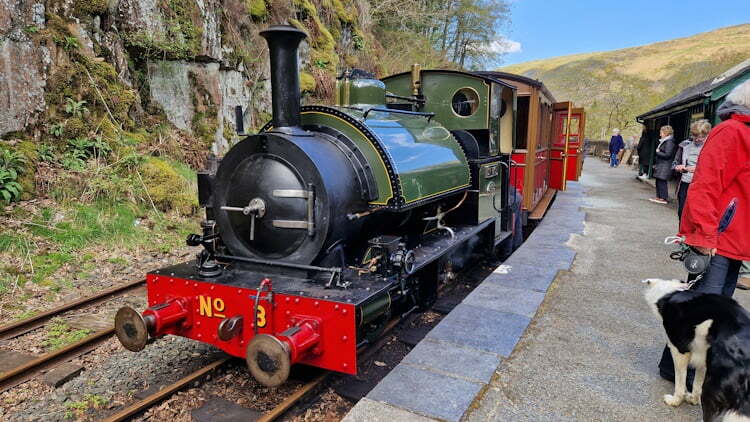
Shortly after we got to Abergynolwyn Station, the 12:15 departure from Tywyn Wharf arrived, being pulled by locomotive No 7 ‘Tom Rolt.’
Leaving Sarah sitting in the sun reading at the station, I took the train on its short journey to Nant Gwernol and back. The train arrived by Abergynolwyn at 13:26, where it stopped for half an hour. I joined Sarah and Mollie on the platform, where we enjoyed lunch.
We then re-joined the train at 13:55 for a 15-minute ride to Dolgoch. No 7 ‘Tom Rolt’ is a 0-4-2 tank engine that entered service in 1991, having been built largely from the parts of an Andrew Barclay 0-4-0 well tank engine built in 1949 for the Bord na Móna railway in Ireland, where it was used to convey vast quantities of mechanically harvested peat.
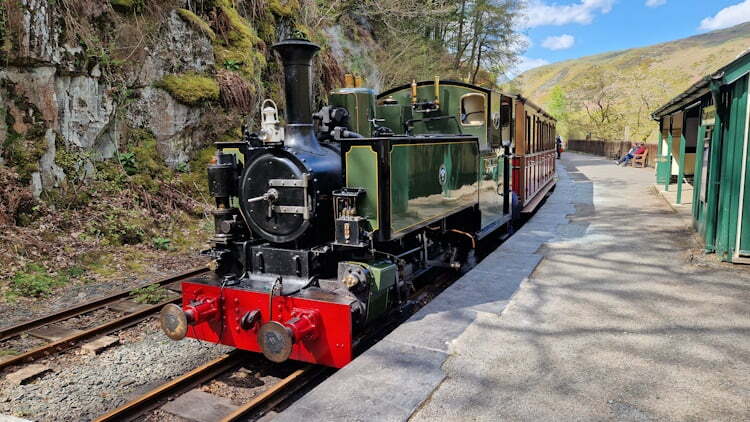
Upon arrival at Dolgoch, we were disappointed to find that the tearoom located close to the station had yet to reopen for the season.
So deprived of our afternoon tea and cake, we did our planned walk to Dolgoch Falls anyway. We have visited the falls many times but never arrived by train before, so this time felt more special than before.
There is a special enchanting atmosphere at the falls, where the crashing noise of water cascading over the fall provides a soundtrack to the wonderful nature of the place.
We were standing looking at the waterfall when a movement at the water’s edge caught our eye; we then stood for several minutes captivated as we watched an otter.
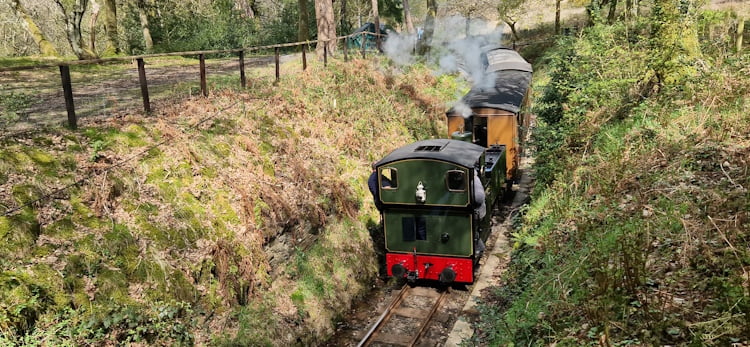
We then caught the 15:55 departure from Dolgoch back to Tywyn Wharf, arriving at 16:27, having had a lovely day on the railway. The Talyllyn railway has a calm and relaxing feel about it; it is one of the friendliest railways I have visited, epitomised by staff at the stations coming onto the platforms as the trains depart to wave to the departing train and passengers.
I have waited far too long to visit this gem of a narrow-gauge railway, and thanks to my membership do not think it will be too long until I return.
Thursday was the last full day of the trip; we once again caught a 158 unit, 158820 again, from Penhelig, our destination this time was Porthmadog passing through the principal stations of Aberdovey, Tywyn, Barmouth, and Harlech, our longest trip along the Cambrian Coast Line.
As well as the main stations, there are numerous small stations and halts, many of them request stops. The line gives stunning views of the coastline, with sandy beaches, sand dunes, cliffs, and spectacular estuaries.
There is moorland and the mountains of Snowdonia, plus the wonderful castle at Harlech. I have heard it said that this is one of the most scenic routes in the UK. I agree.
We walked through Porthmadog from the mainline station to Porthmadog Harbour Station; this station serves both the Ffestiniog line and Welsh Highland Railway.
Whilst waiting for our train to depart, we saw Beyer Peacock 2-6-2+2-6-2T NGG16 Garratt Number NG130, originally built for South African Railways in 1951. It was withdrawn from service in South Africa in 1985 and came to the Welsh Highland Railway in 2015, where it was restored and returned to service in 2021.
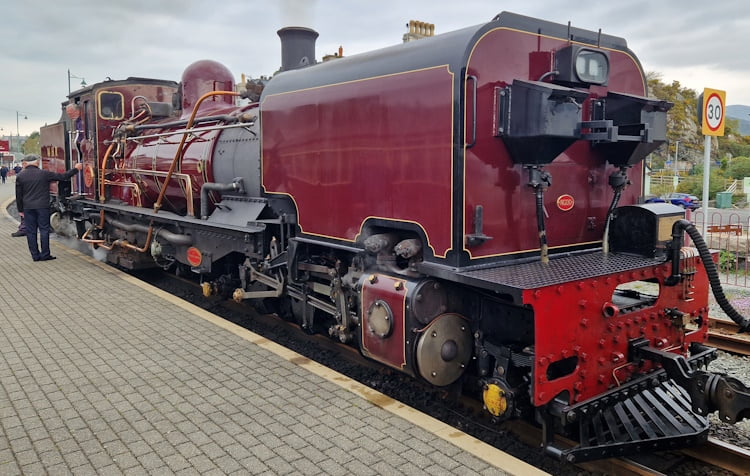
The loco was preparing to take a train along the Welsh Highland Railway. We also saw locomotive 190 ‘Lyd,’ a 2-6-2 locomotive built by the Ffestiniog Railway at its Boston Lodge works to the specification and design of Lynton and Barnstaple Railway Locomotive E188 ‘Lew,’ which was built by Manning Wardle in 1925.
Lyd was completed and entered service on the Ffestiniog in 2010 and carried the distinctive Southern Railways livery as would have at one time been carried by ‘Lew.’

We traveled on the Ffestiniog railway to Blaenau on the ‘Mountain Spirit’ service at the cost of £44 per adult passenger; this is not a cheap day out, although probably worth it.
Our Talyllyn Railway membership, however, gave us half-price tickets, which made the trip more affordable for us. I had wanted to travel on the Ffestiniog railway since I was young, but until this trip had never realised the ambition.
The journey was a truly enchanting voyage, with ever-changing scenery as the train traversed the Glaslyn estuary and then along the Cob embankment, gradually ascending the valley and passing through idyllic pastures and quaint villages before venturing into the ancient, wooded slopes adorning the valley’s periphery.
Upon departing Tan-y-Bwlch station, the train gracefully bids farewell to the encompassing trees while clinging steadfastly to the valley side. After navigating the spiral at Dduallt and traversing a tunnel, the train emerges alongside the captivating Llyn Ystradau reservoir, with its slate tips dominating in the distance. Each segment of the journey unravels its own captivating narrative.
Constructed between 1833 and 1836, the Ffestiniog Railway was built to transport slate from the various quarries around the Town of Blaenau to the port of Ffestiniog. The line initially used horses to pull empty slate wagons uphill and gravity to return loaded trains to Porthmadog.
From 1863 steam engines replaced horses to cope with the increasing demand for slate and the capacity of the railway to transport it. From the 1920s, the slate industry in the area began to decline, and the railway began to introduce some passenger services for workers with tourist trains in the summer months.
Passenger services stopped running in 1939, and slate trains in 1946. Passenger service restarted in 1955 between Porthmadog and Boston Lodge, with the full line not being fully reopened until 1988.
Our train was operated by the distinctive Double Fairlie locomotive ‘Merddin Emrys.’ The Double Fairlie engines were ingeniously designed over a century and a half ago specifically for the purpose of hauling large trains along the challenging gradients and sharp bends of the Ffestiniog line.
These idiosyncratic locomotives, including the loco that pulled our train Merddin Emrys, whose construction was finalized in the year 1879, and the illustrious David Lloyd George, completed in 1992, have all been meticulously crafted within the railway’s own historic workshops at Boston Lodge.
A brand new Fairlie locomotive named ‘James Spooner’ is currently being built and is expected to be finished soon.
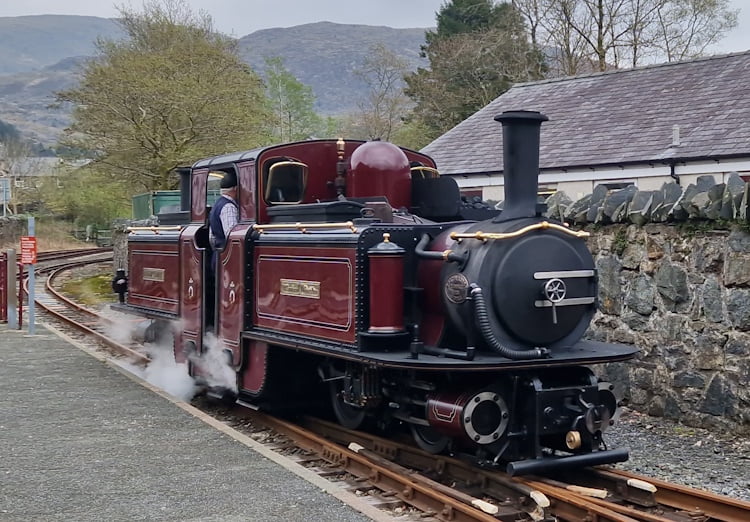
We had half an hour in Blaenau before our train returned to Porthmadog, the stop should have been 40 minutes, but we were a bit late arriving.
On our journey along the Ffestiniog, we saw two other locomotives in steam, one on either end of a short works train at Tan-y-Bwlch station. The first was Arnold Jung 0-4-0WT, Works No.3175/1921, ‘Jenny,’ which is normally based on the Richmond Light Railway in Kent, which was visiting the railway.
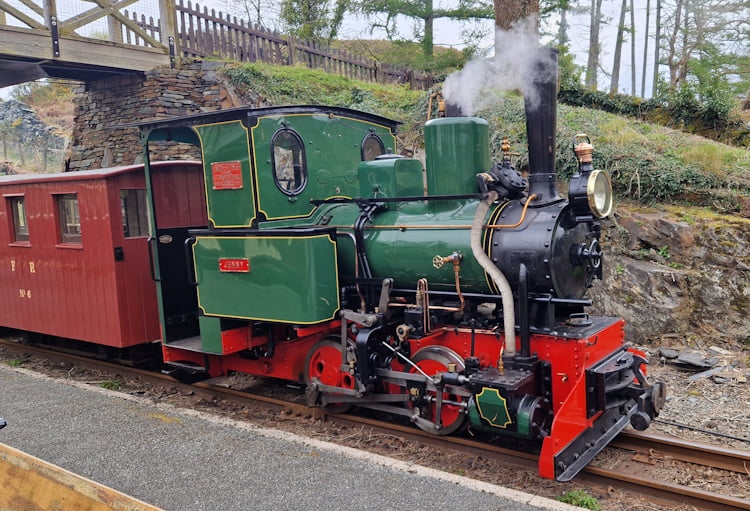
The second was the 0-4-0 Hunslet quarry tank ‘Hugh Napier,’ which is owned by the National Trust and spends most of its time on the Ffestiniog Railway. It was a joy to see these wonderful engines.
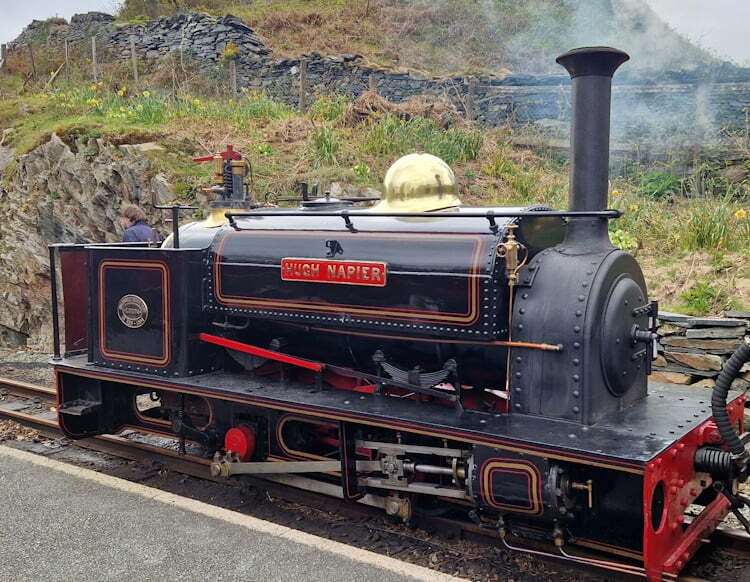
The best part of half a century’s anticipation of riding on the Ffestiniog did not disappoint; it is a wonderful railway. It has a much more formal and business-like atmosphere than the more friendly and laid-back Tallylyn Railway. I am finally delighted to have travelled on both.
The next day we drove home. I am already thinking about a similar short breaks taking in the Vale of Rheidol Railway, Welsh Highland Railway, Welsh Highland Heritage Railway and Corris Railway.


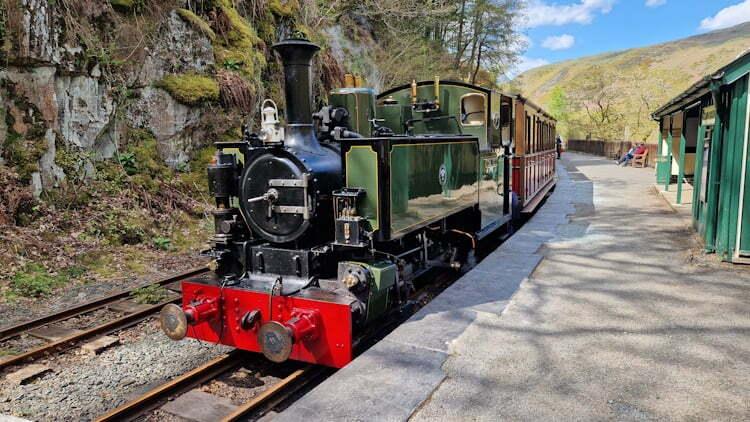



Responses
Greatly enjoyed reading of John’s travels. I have very fond memories of visiting the Ffestiniog in about 1984, before it had re opened in full. Must re visit